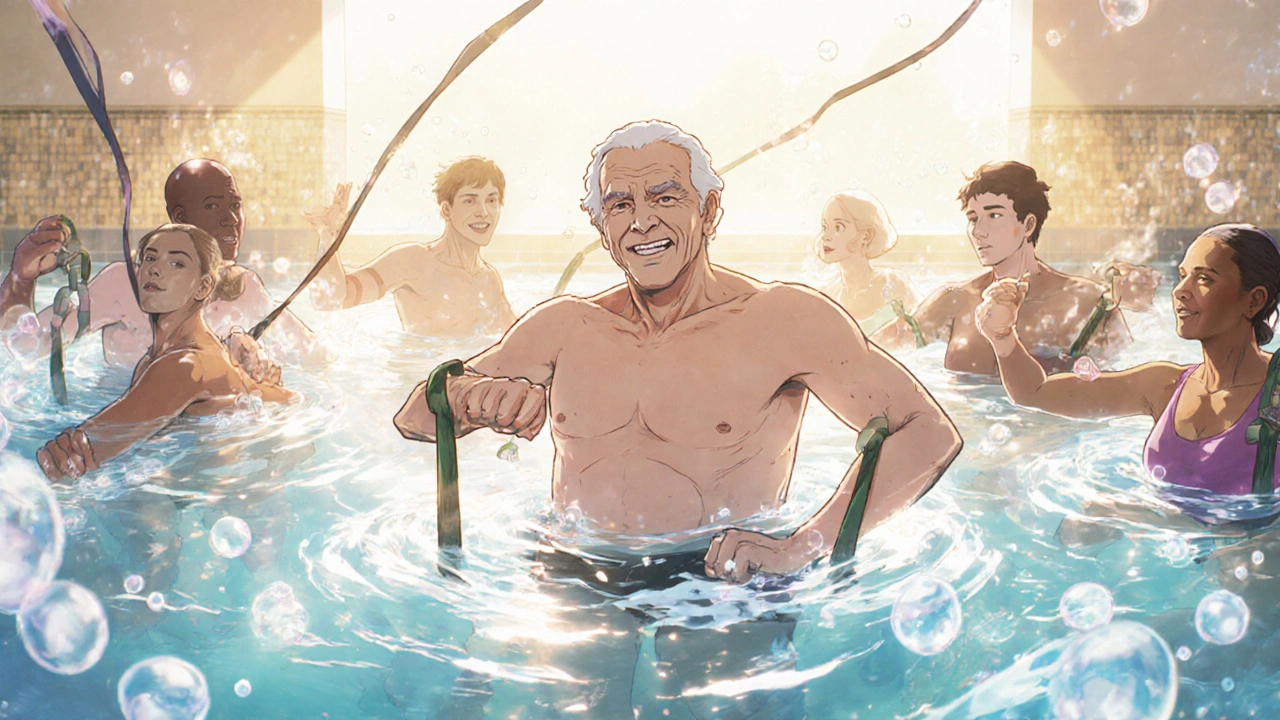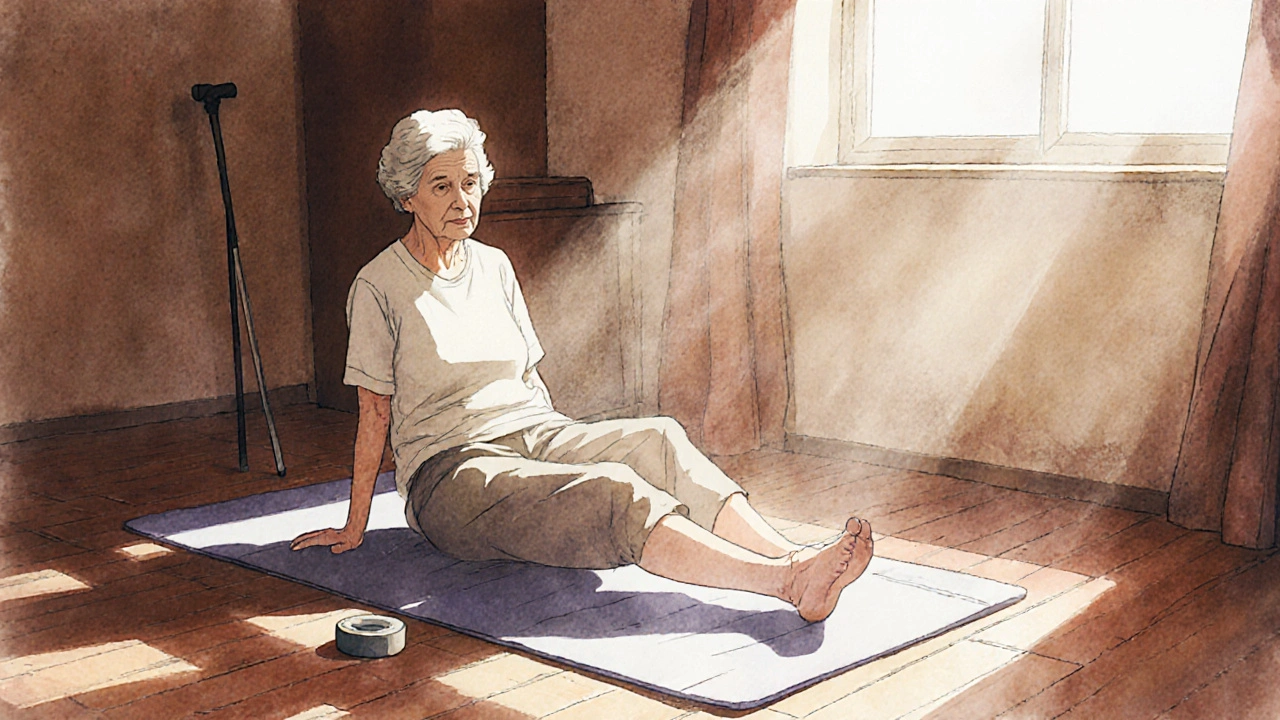When your knees ache climbing stairs, your hips stiffen getting out of a chair, or your hands won’t grip a coffee cup like they used to, it’s not just aging-it’s a joint disorder. And the most effective, science-backed way to take back control isn’t another pill or an immediate surgery. It’s physical therapy. Specifically, targeted range of motion and strengthening exercises that restore movement, reduce pain, and keep you active longer.
Why Movement Is Medicine for Arthritic Joints
For decades, people with joint pain were told to rest. Avoid activity. Don’t push through discomfort. But that advice has been flipped on its head. Today, experts agree: movement is the most powerful tool you have. The American College of Rheumatology’s 2021 guidelines made it official-exercise isn’t just helpful for rheumatoid arthritis and osteoarthritis. It’s disease-modifying. Studies show people who stick with a structured physical therapy program slow joint damage by 23% compared to those who don’t.Why does this work? Joints need motion to stay healthy. Cartilage doesn’t have its own blood supply. It relies on movement to pump in nutrients and flush out waste. When you stop moving, the joint stiffens, muscles weaken, and pain gets worse. It’s a cycle-and physical therapy breaks it.
Range of Motion: Getting Back What You Lost
Range of motion (ROM) exercises aren’t just about bending and straightening. They’re about retraining your joint to move through its full, pain-free arc. For knee osteoarthritis, the gold standard is terminal knee extension-slowly straightening the knee from a slightly bent position. Do 3 sets of 10 to 15 reps, five days a week, with light resistance like an ankle weight (2.5 kg). Keep pain under a 3 out of 10 during the exercise. Too much pain? You’re pushing too hard.For hips, it’s gentle hip circles and seated leg slides. The goal isn’t to force motion-it’s to regain what’s been lost. A 2023 study found that people with mild-to-moderate hip OA who did daily ROM exercises improved their ability to walk without pain by 41% in just 8 weeks. That’s not magic. That’s mechanics.
Water helps. Aquatic therapy at 33-36°C (91-97°F) reduces joint pressure by up to 80%. You can move more freely in the water, build confidence, and reduce pain. Three sessions a week, 30-45 minutes each, is the sweet spot for most people.
Strengthening: The Real Game-Changer
Strengthening is where the real transformation happens. Strong muscles act like shock absorbers for your joints. They take pressure off damaged cartilage and stabilize wobbly joints.For knee OA, focus on quadriceps and hamstrings. Use resistance bands or light dumbbells. Start at 40-60% of your one-rep max-meaning you can do 12-15 reps before your muscles feel fatigued. Do this twice a week. Increase weight by 0.5-1.0 kg every week if you’re not sore the next day.
For hip OA, hip abductor strengthening is critical. Lie on your side, lift your top leg slowly, hold for 2 seconds, lower. Use a resistance band around your thighs if you’re ready. Three sets of 15 reps, three times a week. Research shows this single exercise improves walking speed and reduces falls by 34% in older adults.
And don’t ignore your core. A strong midsection helps your hips and knees work better. Planks, bird-dogs, and dead bugs are low-impact, high-reward moves.

What Works Better Than Surgery? (Yes, Really)
Here’s a fact that surprises most people: for mild-to-moderate hip osteoarthritis, physical therapy can deliver the same functional results as a total hip replacement-at 12 months. A 2023 study in Arthritis & Rheumatology found no significant difference in pain or mobility scores between patients who did PT and those who had surgery. The big difference? Surgery patients spent 2.7 years longer avoiding an operation.Same goes for knees. Medicare data shows patients who do at least 8 sessions of physical therapy before a total knee replacement have 22% lower total treatment costs and shorter hospital stays. Insurance companies are catching on. Starting in 2023, CMS requires a minimum of 8 PT sessions before approving a knee replacement for Medicare patients.
That’s not a coincidence. It’s policy built on evidence.
When Physical Therapy Doesn’t Help
It’s not a cure-all. If joint space narrowing on an X-ray is more than 50%, exercise alone won’t reverse structural damage. In those cases, PT still helps with pain and function-but it won’t rebuild cartilage. That’s when surgery becomes the next logical step.Also, generic exercise plans fail. A 2022 study found that only 12-15% of people respond to “one-size-fits-all” routines. But when a physical therapist designs a plan based on your specific joint, strength level, pain triggers, and goals? Success jumps to 65-70%.
That’s why seeing a licensed physical therapist matters. They don’t just show you exercises. They assess your movement, identify muscle imbalances, correct your form, and adjust your program as you progress.

Real People, Real Results
On Healthgrades, physical therapy for joint disorders has a 4.2 out of 5 rating. Why? Because people get their lives back.One Reddit user, 68, with knee OA: “After 3 weeks of terminal knee extensions, I could stand up from my couch without using my hands. I cried. I hadn’t done that in two years.”
Another, 59, with hip pain: “I stopped PT after two weeks because it hurt. My therapist told me, ‘It’s supposed to feel like a workout, not a wreck.’ I came back. Now I walk my dog 5 miles a week.”
But it’s not easy. 41% of people report increased pain in the first two weeks. That’s normal. It’s your body adapting. But 33% quit because they can’t get to appointments. Rural patients are 2.4 times more likely to drop out. That’s why telehealth is growing fast. New billing codes as of January 2025 let insurers pay for remote PT sessions using wearable sensors that track your movement accuracy.
How to Start-Step by Step
1. See a physical therapist. Not a gym trainer. Not a YouTube video. A licensed professional trained in musculoskeletal disorders. They need 120 hours of specialized training just to handle joint cases. 2. Get assessed. They’ll measure your range of motion, strength, balance, and pain levels using tools like the HOOS or KOOS scores. Don’t skip this. It’s your baseline. 3. Start slow. Acute phase (first 2 weeks): gentle ROM only. No heavy lifting. Pain under 3/10. 4. Progress. Subacute phase (weeks 2-6): add isometric holds-tighten muscles without moving the joint. Then move to light resistance. 5. Push forward. Functional phase (6+ weeks): dynamic movements. Squats, step-ups, lunges-with control. 6. Track progress. Your therapist will retest every 4-6 weeks. A 10-point improvement on the HOOS score? That’s clinically significant. That’s success.The Bigger Picture
The global physical therapy market for joint disorders hit $48.7 billion in 2023-and it’s growing fast. Why? Because people are waking up. And insurers are catching on. Physical therapy saves $1,200-$2,500 per patient per year by reducing meds, avoiding surgery, and keeping people working and living independently.Imagine if 185,000 joint replacements were avoided every year. That’s $9.2 billion in savings. That’s not just money. That’s quality of life.
Physical therapy isn’t a last resort. It’s the first, best, and most powerful thing you can do for your joints.
Can physical therapy really replace surgery for joint pain?
For mild-to-moderate osteoarthritis, yes. Studies show physical therapy delivers the same functional improvements as hip or knee replacement surgery at 12 months. It doesn’t fix the damaged joint, but it restores movement and reduces pain so well that many people delay or avoid surgery entirely-sometimes for years.
How long does it take to see results from physical therapy?
Most people notice less pain and better movement within 4-6 weeks. Significant improvements in daily function-like climbing stairs or standing from a chair-often show up by week 8. Full results take 12-16 weeks, especially if you’re rebuilding strength. Consistency matters more than intensity.
Is it normal to feel more pain when starting physical therapy?
Yes, but only temporarily. The first 1-2 weeks may feel tougher as your muscles and joints adapt. Pain should stay below a 3 out of 10 during exercises and go away within 24 hours. If pain spikes after every session or lasts longer than two days, tell your therapist. You may be pushing too hard or doing the wrong exercise.
Do I need special equipment for home exercises?
Not necessarily. Resistance bands, light dumbbells (2.5-5 kg), and a sturdy chair are enough to start. For water therapy, you just need access to a warm pool. Many exercises can be done with body weight alone-like heel slides, seated marches, or wall squats. Your therapist will tailor the tools to your access and budget.
What if my insurance won’t cover enough physical therapy sessions?
Many insurers limit visits to 10-20 per year. That’s often not enough. Ask your therapist for a home program you can do between sessions. Some clinics offer maintenance plans at reduced rates. Medicare now covers maintenance PT for chronic joint conditions starting in 2026. Also, check if your plan covers telehealth PT-remote sessions are often easier to get approved.
Can I do physical therapy on my own without a therapist?
You can do exercises on your own, but you won’t get the same results. A physical therapist identifies your specific weaknesses, corrects your form, and adjusts your plan as you improve. Generic online routines fail for 85% of people because they don’t match your unique condition. If you can’t afford regular visits, ask for a single assessment and a personalized home plan.
How do I know if my physical therapy program is working?
Your therapist will use validated tools like the HOOS (for hips) or KOOS (for knees). A 10-point increase on these scores is considered clinically meaningful. You’ll also notice real-life changes: walking farther, climbing stairs without stopping, getting out of bed without pain, or not needing painkillers as often. Track these milestones-they matter more than numbers.
Are there exercises I should avoid with joint disorders?
Avoid high-impact activities like running, jumping, or deep squats if you have advanced joint damage. Also skip exercises that cause sharp pain or joint clicking. Instead, focus on controlled, low-impact movements: cycling, swimming, seated leg extensions, and step-ups. Your therapist will tell you what’s safe based on your X-rays and symptoms.



13 Comments
Michelle N Allen
November 28, 2025 AT 01:30So let me get this right we’re supposed to believe that moving your knee around is better than a brand new joint that’s been engineered to last 20 years? I’ve seen people spend months doing these exercises and still end up on the surgery table anyway. All this talk about science feels like marketing fluff when your actual pain doesn’t care about studies
Madison Malone
November 28, 2025 AT 09:25I just started PT last month after years of avoiding it because I thought it was just stretching. Turns out it’s not about being strong-it’s about being smart. My therapist noticed I was favoring one side and fixed my whole gait. I can now walk to the mailbox without wincing. It’s not magic but it’s real
Graham Moyer-Stratton
November 28, 2025 AT 11:04Surgery is for weak people who quit. PT is for warriors. Stop coddling your body. Move or die
tom charlton
November 29, 2025 AT 12:24It is imperative to underscore the clinical validity of physical therapy as a first-line intervention for degenerative joint conditions. The evidence base is not merely supportive-it is robust, longitudinal, and reproducible across diverse populations. Furthermore, the economic implications for healthcare systems are profoundly positive when conservative management is prioritized
Jacob Hepworth-wain
December 1, 2025 AT 10:38I used to think PT was just for old folks but my buddy did it after a bike crash and now he’s hiking again. Just gotta be consistent. No magic just hard work and someone who actually knows what they’re doing
Craig Hartel
December 3, 2025 AT 07:57I’m from a small town where the nearest PT clinic is 90 minutes away. When I found out about telehealth PT with sensors I cried. My mom’s been doing her hip exercises on her phone while sitting in her rocking chair. She says she feels like herself again. This is huge for rural folks
Chris Kahanic
December 4, 2025 AT 18:56The data presented is compelling. However, one must consider the attrition rate. If 41% of patients discontinue due to logistical barriers, then the efficacy of the protocol is contingent on accessibility. Without systemic solutions, individual success remains statistically isolated
Geethu E
December 4, 2025 AT 21:40I’ve been a physio in Mumbai for 18 years and I’ve seen this work every single day. People think it’s just exercises but it’s about retraining the brain too. Your body forgets how to move when it’s in pain. PT brings it back. And no you don’t need fancy gear-just a wall and your own willpower
anant ram
December 6, 2025 AT 13:45Let me tell you something important: physical therapy is not just about doing exercises-it’s about consistency, patience, and proper form. You need to do it every day, not just when you feel like it. And if you’re doing it wrong, you’re not helping yourself-you’re hurting yourself. So please, listen to your therapist. Don’t guess. Don’t YouTube. Don’t wing it. You’re not a scientist. You’re a patient. And patients need guidance.
Michael Segbawu
December 7, 2025 AT 16:38They want you to do PT so they can keep you on painkillers longer and make more money. Surgery is the real fix. PT is just a way to keep you hooked on the system. I know because I saw the receipts. My cousin did PT for two years and still got replaced. The system wins again
Alexis Mendoza
December 9, 2025 AT 05:33If movement is medicine then why do we treat it like a chore? We don’t brush our teeth once a month and call it good. Why do we do that with our joints? Maybe the problem isn’t the joint-it’s the way we’ve forgotten how to care for our bodies. PT isn’t treatment. It’s remembering how to be alive
king tekken 6
December 9, 2025 AT 22:35Okay but have you heard about the 2024 WHO report that says PT clinics are secretly funded by pharmaceutical companies to delay surgeries so they can sell more NSAIDs? I mean think about it-why would insurance push PT if it wasn’t profitable for someone? And why do all the studies come from universities that get pharma grants? Wake up people
DIVYA YADAV
December 11, 2025 AT 03:59Look I’ve lived through three administrations and every time they say PT is the answer it’s because they’re cutting healthcare budgets. They don’t care about your knees they care about the bottom line. They’d rather pay for 1000 PT sessions than one $50k surgery. And they’ll tell you it’s science while they starve rural clinics. You think this is about health? It’s about profit. And they’re using your pain to justify it